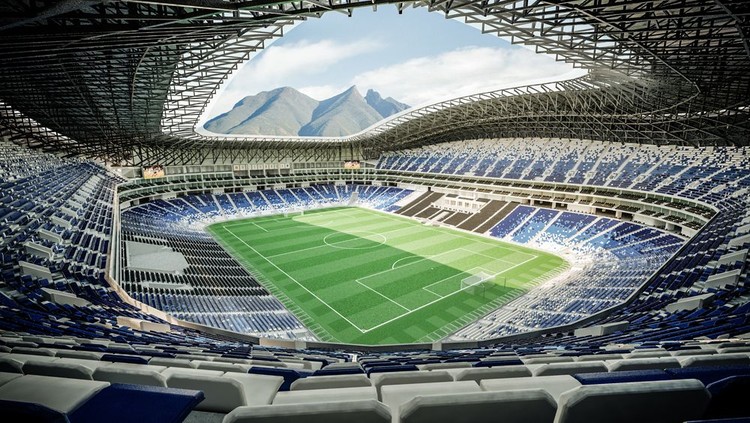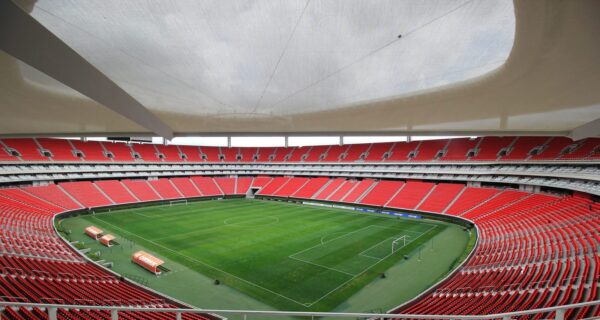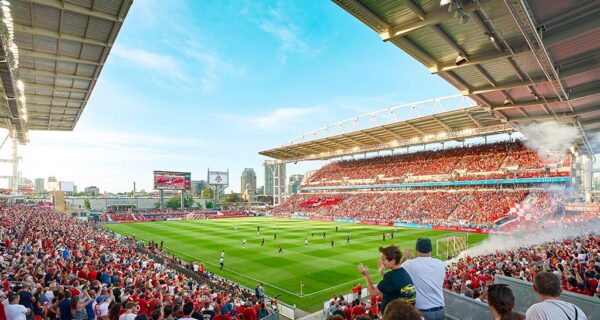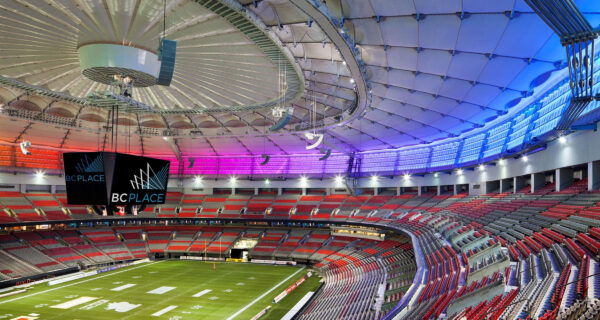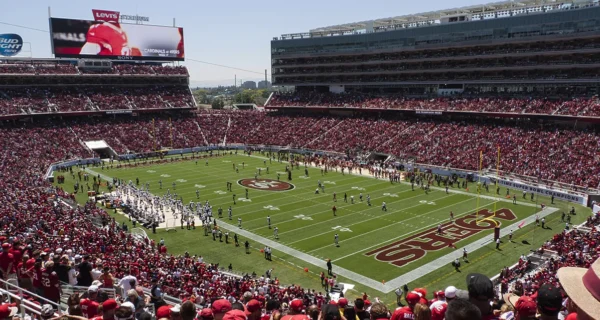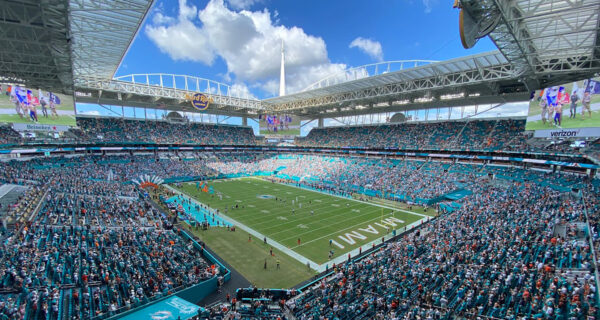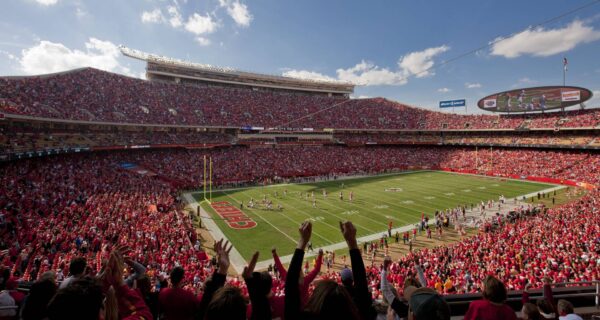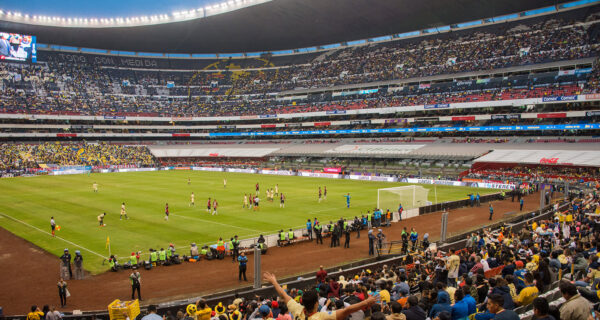This Article Contains
Estadio BBVA ranks as one of Mexico’s premier football venues and will soon welcome international fans for the 2026 FIFA World Cup. This modern stadium combines innovative design, fan-focused amenities, and sustainability features that set new standards for sports venues across Latin America.
The stadium serves as home to C.F. Monterrey (Rayados) and has earned recognition as “El Gigante de Acero” (The Steel Giant) among football enthusiasts.
Estadio BBVA Stadium Capacity and Size
Estadio BBVA boasts a total capacity of 53,500 spectators, making it the fourth largest stadium in Mexico. The stadium opened in 2015 with an initial capacity of 51,000 but expanded to its current size in 2016. The owners added more seats to accommodate the growing fan base of C.F. Monterrey.
The seating arrangement brings fans incredibly close to the action. The first row sits just 9 meters from the playing field, compared to 27 meters at the club’s previous venue. This proximity creates an intimate atmosphere despite the stadium’s large size.
The steep 34-degree incline of the grandstands ensures excellent visibility from every seat. Designers prioritized the fan experience by creating unobstructed sightlines throughout the venue. This architectural choice helps generate an electrifying atmosphere during matches.
Location and Surrounding Area
Estadio BBVA sits in Guadalupe, a suburb in the southeastern part of the Monterrey metropolitan area in Nuevo León, Mexico. The precise address is Av. Pablo Livas 2011, La Pastora, Guadalupe, with coordinates 25.669180, -100.244614.
The stadium forms part of the Parque La Pastora complex, bordering the local zoo on its western edge. This strategic location helps establish the area as a growing leisure destination for the region. The eastern side neighbors a low-rise residential and commercial district.
A unique feature of the location involves the stunning backdrop of Cerro de la Silla Mountain. The stadium’s design deliberately frames views of this iconic natural landmark from the northern stands. This integration of natural surroundings enhances the overall spectator experience.
Revolutionary Architectural Design
Renowned architecture firm Populous, in collaboration with Mexican firm VFO, designed Estadio BBVA. Federico Velasco served as lead designer alongside Populous for this ambitious project. Construction began in August 2011 and reached completion in July 2015.
The design draws inspiration from Monterrey’s rich industrial heritage. The self-supported tripodal structure pays homage to the city’s steel manufacturing tradition. The asymmetric sweeping shape of the exterior evokes the silhouette of brewing stills, nodding to Monterrey’s brewing history.
The stadium features a distinctive roof with aluminum gills that allows breezes to enter. This innovative design element improves natural ventilation throughout the venue. The dramatic cantilevered roof extends 55 meters and provides shade for spectators.
The exterior façade incorporates rolled steel trusses clad in aluminum. This metallic armature creates a sculptural form visible from a distance. The designers illuminated the gills at the top of the exterior, extending the visual impact into the evening hours.
Industry-Leading Sustainability Features
Estadio BBVA demonstrates a strong commitment to environmental responsibility. The stadium earned a silver certification from Leadership in Energy and Environmental Design (LEED) for its eco-friendly approach. This recognition acknowledges the venue’s sustainable design and operational practices.
The landscape design takes inspiration from the natural environment, connecting the mountain and river. The project included planting two thousand native trees around the stadium. These species have an average lifespan of 175 years, creating a lasting green space.
The parking areas feature a permeable “Grasspave” system that allows for both vehicle transit and water absorption. This innovative solution helps maintain the natural hydrological cycle. The stadium’s structure captures rainfall runoff and conducts it to the La Silla River.
Surrounding the stadium, 25,000 square meters of heat-resistant, low-water-consumption grass act as “gardens” that capture and filter rainwater. These green spaces contribute to the overall environmental strategy of the venue. The comprehensive approach to sustainability marks Estadio BBVA as a forward-thinking sports facility.
Premium Amenities and Fan Comforts
Estadio BBVA offers an unprecedented level of premium amenities for a Latin American stadium. The venue includes 324 luxury suites with high-end finishes and upscale food concessions. This extensive suite offering exceeds most comparable venues in the region.
Two club lounges accommodate a total of 4,500 club seats. These exclusive areas feature high-end drink bars, gourmet food offerings, and outdoor terraces. One club area includes a dedicated kids’ zone with separate dining options.
The premium experience extends to unique viewing opportunities. A special balcony allows fans to watch players entering the field via the access tunnel. This feature adds excitement to the pre-match atmosphere and creates memorable moments for spectators.
Throughout the concourses, multiple screens display the on-field action. This ensures fans never miss important moments when visiting concession areas. The comprehensive approach to fan comfort demonstrates the stadium’s commitment to an elevated match-day experience.
Convenient Transportation Options
Fans can reach Estadio BBVA through various transportation methods. The Metrorrey train system provides direct access via Line 1. Visitors should travel to the Exposición station, with a short 10-minute walk to the stadium.
Numerous bus routes service the venue, offering affordable transportation options. The closest bus stops include Las Torres (Estadio B.B.V.A.), Pablo Livas (Las Quintas – Las Torres), and Pablo Livas (Estadio B.B.V.A.). These stops place fans within minutes of the gates.
For those driving to matches, parking requires advance planning. The stadium provides parking for approximately 3,500 vehicles, primarily for season ticket holders with annual parking passes. Additional parking options exist in adjacent areas but may fill quickly on match days.
Rideshare services offer another convenient option for reaching the stadium. Local taxis provide service from Monterrey Airport to Estadio BBVA in approximately 22 minutes. The journey covers 14.4 miles and offers a direct route to the venue.
FIFA World Cup 2026 Plans
Estadio BBVA will serve as a key venue for the 2026 FIFA World Cup. During the tournament, FIFA will rename it “Estadio Monterrey” to comply with regulations regarding commercial branding at World Cup venues. This temporary name change follows standard FIFA practice.
The stadium will host four matches during the tournament. These include three group stage matches scheduled for June 14, 20, and 24, plus one Round of 32 match on June 29. These international fixtures will showcase the venue to a global audience.
In preparation for the World Cup, the stadium will install a state-of-the-art LED sports lighting system from Musco Lighting. This upgrade will meet FIFA Lighting Standard A requirements. The system will reduce energy consumption by more than 40 percent and enable color-changing light shows.
Additional enhancements may include updates to pitch surfaces, seating improvements, accessibility modifications, and security system upgrades. These changes will ensure the stadium meets FIFA’s exacting international standards for such a major tournament.
FAQs
1. When was Estadio BBVA built and how much did it cost?
Estadio BBVA was built between 2011 and 2015, with construction officially completed in July 2015. The stadium cost approximately US$200 million, making it the most expensive stadium in Mexico at the time of its construction.
2. What teams play at Estadio BBVA?
C.F. Monterrey, commonly known as Rayados, serves as the primary tenant of Estadio BBVA. The team moved to this venue in 2015 after 63 years at their previous home, Estadio Tecnológico.
3. How can visitors reach Estadio BBVA using public transportation?
Visitors can take the Metrorrey Line 1 to Exposición station, followed by a 10-minute walk. Multiple bus routes also service the stadium, with stops including Las Torres (Estadio B.B.V.A.) and Pablo Livas (Estadio B.B.V.A.).
4. What sustainability features does Estadio BBVA incorporate?
Estadio BBVA earned LEED silver certification for sustainable design. Features include two thousand native trees, permeable parking surfaces, rainwater capture systems, and 25,000 square meters of low-water-consumption grass areas.
5. How many luxury suites does Estadio BBVA contain?
The stadium houses 324 luxury suites with high-end finishes and premium food offerings, making it one of the most suite-rich venues in Latin America. These luxury spaces provide exceptional views and upscale amenities for exclusive fan experiences.
6. What matches will Estadio BBVA host during the 2026 FIFA World Cup?
Estadio BBVA will host four matches during the 2026 World Cup: three group stage matches on June 14, 20, and 24, plus one Round of 32 match on June 29. The stadium will temporarily adopt the name “Estadio Monterrey” during the tournament.
7. What inspired the architectural design of Estadio BBVA?
The design draws inspiration from Monterrey’s industrial heritage, including steel manufacturing and brewing history. The stadium’s asymmetric shape evokes brewing stills, the steel structure honors the city’s manufacturing tradition, and the design frames views of Cerro de la Silla Mountain.
8. Does Estadio BBVA offer special viewing areas?
Yes, the stadium features two club lounges with 4,500 premium seats, outdoor terraces, and a special balcony where fans can watch players enter the field through the access tunnel. These areas enhance the viewing experience for premium ticket holders.
9. What changes will Estadio BBVA undergo before the 2026 World Cup?
The stadium will install an advanced LED lighting system meeting FIFA Lighting Standard A. Additional upgrades may include pitch improvements, seating enhancements, accessibility modifications, and security system updates to meet international tournament standards.
10. What is the nickname of Estadio BBVA?
Estadio BBVA carries the nickname “El Gigante de Acero” (The Steel Giant), referencing both its impressive size and the metallic architectural elements that honor Monterrey’s steel industry. The name perfectly captures the stadium’s imposing presence and industrial aesthetic.

